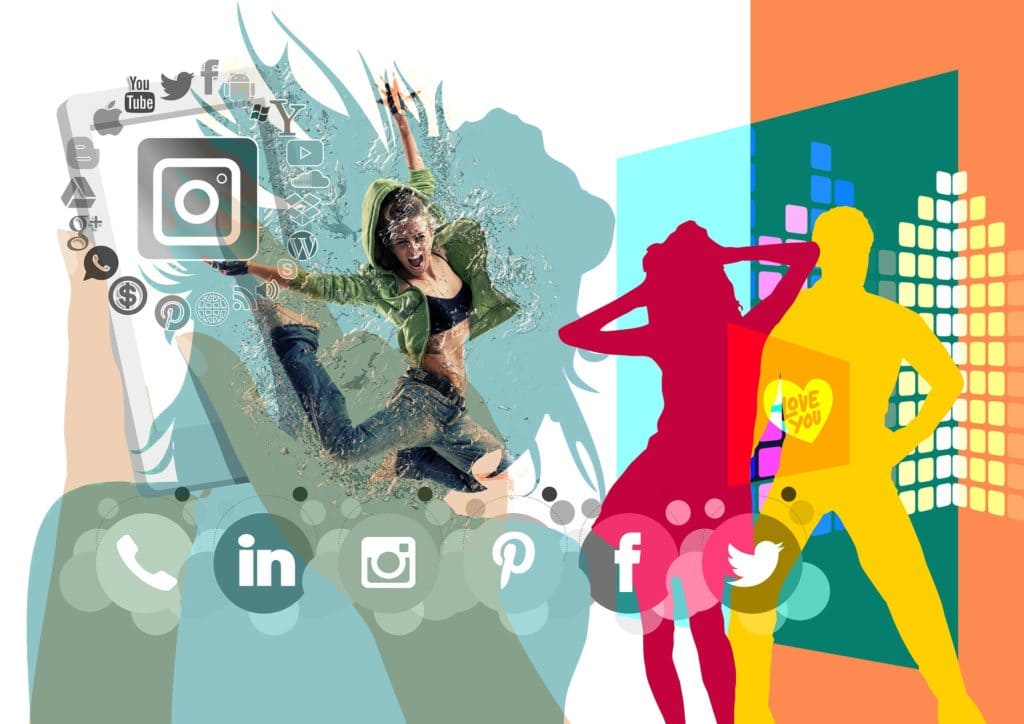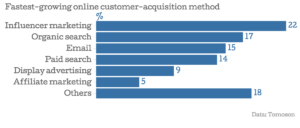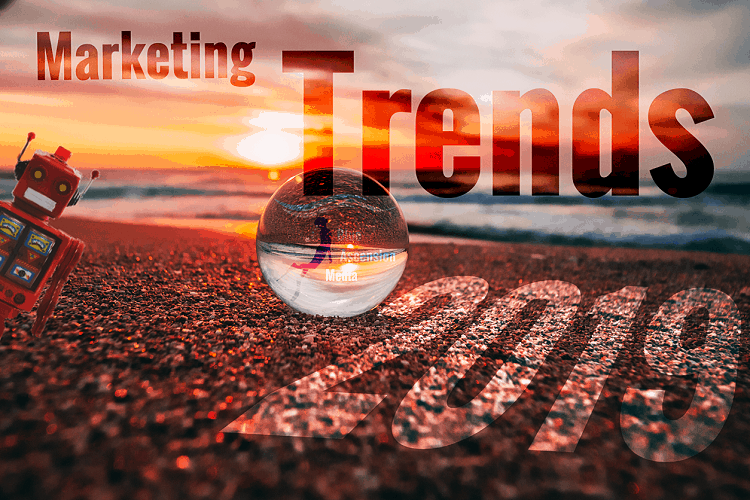Are you ready to rock your business in 2019?
Here are seven of the most powerful trends that can help your business stand out, attract more customers, provide value, and develop your customers into advocates that keep your company top-of-mind.
Ready? Let's dive In.
Trend 1:
Video
What is it?
If you feel like video is everywhere, you’re right. From scrolling through the videos on your social media feeds to watching the retail giants’ Super Bowl ads, video is here. And it’s only going to get bigger.
One reason it’s becoming the go-to vehicle for information sharing is that it’s easy to consume. You can watch it anywhere. And let’s face it. It’s just easier to watch a video than it is to read content. Our brains also crave newness, so video — with its motion and sound — grabs our attention.
Attention-grabbing video stats
- By 2021, video will take up 80% of all the Internet traffic (😲 80%!) Cisco
- 70% of consumers say that they have shared a brand’s video
- 72% of businesses say video has improved their conversion rate
- 52% of consumers say that watching product videos makes them more confident in online purchase decisions
- 65% of executives visit the marketer’s website and 39% call a vendor after viewing a video
- YouTube is the 2nd largest search engine (in 2018, and 2019 is likely the same)
How can it benefit your business?
If you use video and your competitors don’t, you’re ahead of the pack.
With video, you can share a lot about your product and brand in a short amount of time. Plus, engaging videos can attract new customers and further engage current fans.
You can use it to educate, inspire, inform, and reward your customers.
If you have a complex product or service, educate your customers with quick how-to videos. If you have a visually beautiful business — think flower shop — show how your customer will feel buying fresh flowers. And if your business isn’t obviously video-ready (say, insurance), create short videos that explain common questions clearly and let customers get to know you and trust you as a person.
The sky’s the limit when it comes to creative ways to share your business story and brand through video.
How can you implement video?
Don’t let video scare you. Just start, have fun, and get better as you go.
If you have a Facebook or Instagram business account, get out your SmartPhone and start taking video.
Take video of your product in action. Capture customer reactions when they see their new remodeling project completed (be sure to get their permission to post it). Set up your product in a pretty location and take video that gives a sense of place in your community.
Then upload the clip to social media, add a sentence or two of description, and post it.
That’s it, and then wait to see how your audience responds. Tweak as needed.
You can also hire a videographer and go for a custom video that showcases your business.
Tech tips:
- landscape (horizontal) videos and 1080 pixels wide for main feed (16:9)
- length limits: 60 seconds on Instagram; no limit on Facebook
- portrait (vertical) videos for “Stories” – quick posts that disappear in 24 hours (but you can archive the best ones)
- IGTV is vertical video in longer timeframes than Stories
- embed video into your blog posts
- more and more apps (a lot of them free) are availible to use and try
Trend 2:
Chatbots
What is it?
Those little pop-up boxes that “talk” with you and answer questions you type in are software platforms that use Artificial Intelligence to mimic human conversation. They’re used with messaging platforms like Facebook Messenger and integrated into apps and text SMS platforms.
They can also be used with CRM platforms to capture data on customers, leads, and prospects. Customers will also be able to subscribe to your chatbot to receive regular content or special announcements (the new newsletter?).
Done well, chatbots add humanness to technology, and help your customers get the information they need from the platform they prefer, all in real time.
Chatbot Stats
- Chatbot communication increased dramatically in 2018 and is poised for similar growth in 2019.
- The customer service chatbot market will reach 1.25 million in 2019.
- Facebook messenger has the highest open rate.
- Direct sellers should be investing in training on bot marketing and developing automated sequences (for things like hostess coaching and follow-up).
How can chatbots benefit your business?
A well-programmed chatbot can be your never-needs-a-day-off friendly customer service staff member. Your chatbot can provide answers to the usual questions many customers have: What are your hours? Are you open on Sunday? Where’s your business located? Do you accept Apple Pay?
With use of messaging outpacing social media, chatbots give you an easy way to meet your customer’s simple needs 24/7. Plus, more and more people actually don’t want to talk to a human when they have a simple question. They turn to chatbots to get answers quickly and easily.
By providing answers immediately, your business maintains a great reputation for prompt response, and you’ll be alerted when there’s a question that only a human can answer.
Your chatbot can also:
- Distribute your content through messaging apps
- Reinforce your brand’s customer experience at every step
- Generate leads from people interested in your company
- Increase customer satisfaction by responding in real time
- Deliver targeted content based on your customer’s feedback and interests
- Guide prospects to right content
- Help your customers shop (or suggest add on products)
How can you implement chatbots?
One of the first ways to add a chatbot is to hook one into your Facebook Messenger. While this is not straightforward, there are a number of free and paid options on the market.
Customers get their questions answered immediately, and you can also point them to the relevant pages on your website based on their queries.
🤖 Blue Ascension Media is working on implementing multiple chatbots and will be adding more to this section including a detailed guide in the near future. Be sure to like us on Facebook to be notified for future updates.
Tech Tips:
- instant response of your chatbot means a higher response rating on Facebook, which helps your page’s credibility
- a simple Customer Service chatbot can be loaded with FAQs to provide the first layer of customer response
- always have a way for your customer to reach a real person or to leave a message for you to quickly respond with personalized information. Don’t make your chatbot the electronic version of an endless and maddening phone inquiry system.
- depending on which chatbot software you implement, the same chatbot can be hooked into multiple platforms (e.g. website, facebook, sms)
- start with the conversational flow first and then build the backend to implement. This is a good way to ensure that you have a natural flow.
No matter where you start, focus on implementing your chatbot in one place first, and branch out from there.
Trends 3 & 4:
Voice & Visual Search
What is it?
Alexa, what is voice search and how can I use it for my business?
Whether it’s through the Google voice search capability, the ever-present Siri built in to Apple products, or a voice-assisted device like Amazon’s Echo, Google’s Home Hub, or Facebook’s Portal, your customers are accessing content with voice search more than ever before.
And performing visual search using capability on Google, whether through images.google.com or its Lens app on Android devices, is close behind.


Voice & Visual Search Stats
- According to AdWeek, 67 million voice-assisted devices will be in use in the U.S. by 2019.
- Today, 41% of adults conduct at least one voice search daily. (Forbes)
- 50% of searches will be performed via voice by 2020. (Forbes)
- Visual search is small when compared to total search volume, but it's growing quickly. For example, Pinterest searches grew from 250 million in February 2017 to 600 million in February 2018. (eMarketer)
How can voice and visual search (optimization) benefit your business?
Voice and visual search make it easy for customers to get the information they need on any topic, wherever they are. When your content comes up and meets their needs, it’s another way to attract new customers or more fully connect with your current customers.
Voice search is especially helpful for local searches for your business. When your business pops up for a query like “best Mexican food in San Luis Obispo,” or “where to go wine tasting in Paso Robles,” you stand to gain a lot of traffic.
How can you implement Voice & Visual search?
Voice-activated assistants aren’t magic — they’re pulling their data from content on the Internet. If the content is relevant, easy to access, quick to load, and uses terms that match the query, they’ll grab it. And your business’s info can be the answer they share out of all the similar data on the Internet.
While there are lots of tech tips to optimize your content for voice and visual searches, it still comes down to good content and solid SEO. Following this approach will help your content be findable in all sorts of searches, and that’s the real goal. Part of that is to create or rework your content to meet web accessibility guidelines and be sure your content is machine readable.
Tech Tips (Voice Search):
- Write your content simply, in a conversational tone. Even better is framing your content in a Question & Answer format, with the questions matching those your customers might speak into a voice search.
- Add a list of FAQs that match common questions you get asked a lot.
- “Listen” to your written content. People talk differently than they write. Capture that syntax and simplicity in your content.
- Tweak your existing content to include relevant search terms and written in a natural language.
Tech Tips (Visual Search):
- Put relevant keywords in the image file name.
- Map keyword categories and themes to your images, and use the data in alt tags, titles, and captions.
- Be sure to make photo sizes quick to load — about 1080 pixels is a good rule of thumb.
- Add multiple images to each product or topic page.
- Optimize the images for the web and swift page load.
- Add a call to action in the photo or your URL to make it more useful when it appears in a random search.
- Be sure your images are hosted on authoritative pages that respond to a specific user intent.
- Create a consistent visual look for all your brand assets to help search engines relate your brand to a particular style.
- If you use a stock image, tailor it to your unique content so it stands apart from the same image used thousands of times. Search engines will find it difficult to understand your image if it is replicated across the web in different contexts.
- Monitor your search traffic reporting for visual results to spot trends or demand.
Trend 5:
Storytelling
What is it?
Gone are the days of marketing being a one-way push of information outward to customers. Today, your customers want to be seen as individuals with unique needs and they want to develop a longer-term relationship with companies they can trust and believe in.
One way to do this is viewing your content as a story with your customer as the leading character. How can your product or service help them solve challenges, improve their lives, increase their connection with others, or simply have a few moments of quiet or humor in their busy day?
How can storytelling benefit your business?
Customers aren’t keywords. They’re human being searching for something to fill a need or ease a pain point.
When your content moves beyond a one-time post to content that can inspire, encourage, educate, and provide value over time, you can gain long-term customers that choose your company over the competition offering “the same” product or service.
Providing a longer-term view of customer nurturance rather than a one-time sale can create true fans — loyal and who can become lifetime advocates who rely on your business and share it with others.
The value of personal recommendations is worth infinitely more than finding a new customer for a single transaction.
How can you implement storytelling into your content?
Content is more than sales-speak and pushing a product or special offer. Develop content that your customers care about and want to share with their friends and family.
Go deeper: share the reason you started your company, the people who make it special, and the customers you’ve been with you over time.
Find ways to create experiences and foster an ongoing relationship with customers. When it’s time to buy, they’ll come to you.
With every piece of content, think of two-way communication. How can you engage with your customers and start a conversation?
With every piece of content, think of two-way communication. How can you engage with your customers and start a conversation?
Trend 6:
Micro Moments
What are Micro Moments?
Micro moments are those split-second decisions to get on our mobile device and find what we need to know — right now. Whether it’s searching for a lunch spot, a nearby ATM, the best place to do wine tasting, or the best tires for our car, we expect instant answers.
More and more people are using in-the-moment search to shape and validate their decisions. Now is the time to learn and leverage these concepts.

The intent behind most queries:
I want to know
I want to go
I want to do
I want to buy
How can using micro moments benefit your business?
When your business can provide the answers to these four micro-moment topics, you can be the top choice for that customer. In fact, several studies show that the first result that best matches a query can even result in spontaneous purchases if you have a way for the customer to buy a related product that second.
And providing instant answers to micro-moment questions is just one piece of the puzzle. When your overall content can take the customer through this arc — from awareness through purchase — your business can reap the rewards of attracting customers by being the solution to their needs.
How can you implement micro moments into your content?
It all comes down to delivering your message quickly — within seconds — and clearly and concisely. If you miss the very small window of opportunity, the customer will move on.
To capitalize on this instantaneous demand, your business needs to come up first. This is a result of good content, good SEO, and being on the platforms that people turn to most frequently. Google, Google Business, Yelp, Foursquare, and others are some of the top platforms.
Tech Tip:
When creating your content, keep in mind the four decision points behind the instant decisions:
I want to know
- Generate excitement about your unique experiences and products.
- Build confidence in your services online and through social content (benefits and what to expect).
- Give more details about your product and services. People don’t want surprises.
I want to go
- “Near Me” searches are the key and work to show up in the top results.
- Make it easy for people to find you on local searches.
- Optimize your local presence with SEO, Google My Business, Yelp, and other local tools.
I want to do
- Identify and highlight the moments your customers want to do.
- Find these by looking at what people are searching for and trends (e.g., Google Trends).
- Create “how to” content to teach your customers about how to enjoy or use your product.
I want to buy
- Find out your customers’ “want-to-buy” moments by talking to them, through surveys, and/or focus groups.
- Be there when they have questions (displays, product videos, chatbots to answer questions, FAQs).
- Work to increase and drive positive reviews of your company online.
- Create and share engaging content through social media and ads.
Trend 7:
Micro Influencers
What are Micro Influencers?
More and more of us follow the recommendations of friends and trusted sources like influencers rather than brand advertising on what to buy, eat, wear, or experience. We are growing wary and weary of being sold to by impersonal advertising campaigns and seek communities of people like us for input on what’s worth our time and money.
While we may follow a few mega influencers for the entertainment or FOMO (fear of missing out) value, those we really trust are micro influencers.

But top influencers demand top fees. And even if you can afford the price tag ($20,000 per post is on the low end), top influencers may not take you on.
What can you do? Click to find out. >>
Reach out to a micro influencer.
With between 1,000 – 10,000 followers, micro influencers are more like us than the online celebrities. They are genuinely passionate about their niche, whether it’s dog training or beauty products. We look to them for their knowledge and expertise, and see them as a source of trusted information on our shared passion.
If you have a smaller brand, don’t think that the smaller audience of a micro influencer means smaller results. The smaller audience actually means much higher engagement rates than the mega influencers, often by a huge margin.
Maximum Results from Micro Influencers
- 92% of consumers trust recommendations from their immediate network over advertisements. (Digital Intelligence Today)
- 82% of consumers said that they were highly likely to follow a recommendation made by a micro influencer. (Pew Research Center)
- 51% of marketers believe they get better customers from influencer marketing, because the relationship began with trust in the influencer.
- Mid-level influencers enjoy much higher levels of engagement when compared to the top-tier influencers or celebrities.
How can working with micro influencers benefit your business?
Working with influencers is a balance between promotion and authenticity. People more and more put trust in a micro influencer’s decisions and opinions.
The key to influencer marketing? Understanding your brand, then finding and building relationships with people you believe align with your brand and your story. Begin by clarifying two things about your audience: the type of content they will respond to, and how they are evolving. Which micro influencer is best at meeting at that point of intersection?
A survey from Burst Media reported that…
“$6.85 in earned media value for every $1.00 of paid media,”
Not bad ROI, if you ask us.
This is even more impressive if you can put this into effect in the aggregate and build it as one component of your holistic campaign strategy .

Influencer marketing is becoming the fastest-growing channel, and the benefits to business are starting to be understood and utilized.
The overall message is that customers acquired over social media, via a trusted source like a micro influencer, tend to spend more and spread the word to friends and family.
How can you utilize micro influencers in your promotions?
The first step on this path is to really watch and see how your local micro influencers are interacting with their followers. What is their message? Are they consistent and do they speak the right message towards your industry’s brands and products?
Another good way is to search hashtags on your brand’s keywords and even on your products. There may be people that are already raving about your brand. They are ideal candidates for being a micro influencer.
There are many tools to see how influencers are performing and it’s not all about number of fans. In the end, it’s about engagement and how this leads to new customers and fans for your business.
Second, looking at this from your perspective, it’s good to know your overall goals for the campaign. This could be new fans, getting people into your store, brand recognition, promoting a special sale or event, getting new email subscribers, etc.
Tech Tips:
- Who’s your audience and target persona?
- Know your budget ahead of time (including trial products, services).
- Have a way to track performance. Some standard KPIs (Key Performance Indicators) are reach, engagement on posts, video views, increase in fans (for you), sales, or subscribers to newsletter or chatbot, and buzz (ask people how they heard about the campaign).
- Give space for the influencer to provide creativity (and authenticity), and request a preview of posts and content prior to launch.
- Understand the platforms (Facebook, Instagram, etc.) and which better serves your brand’s needs and audience.
- Discuss and document the period of performance and posting with a clear schedule.
- Don’t forget to promote and engage on the content as well. All too often, an influencer does a successful post but there is no engagement from the brand. This is where the magic lies.
In the end, finding and working with micro influencers can benefit your brand and business. This is an exciting time and we can’t wait to see how micro influencer marketing continues to evolve in the coming year.
The relationship between brand and influencer is a mutually beneficial one where both gain something meaningful. The best relationships ensure that the brand is in line with the influencer’s aesthetic and audience, and the influencer has creative room to let their own voice shine.





